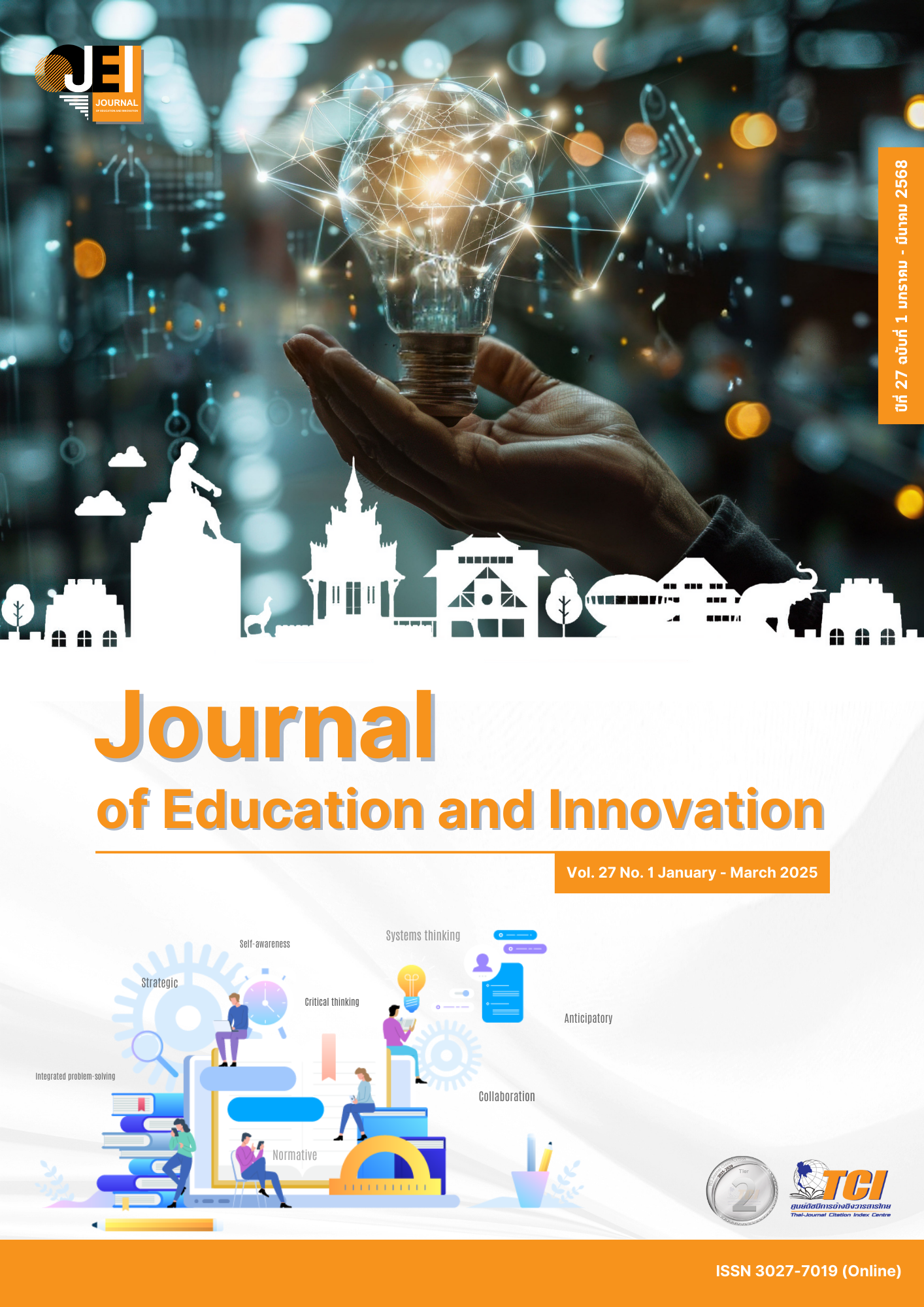A STRUCTURAL EQUATION MODEL OF THE FACTORS INFLUENCING THE EFFECTIVENESS OF SECONDARY SCHOOLS UNDER THE SECONDARY EDUCATIONAL SERVICE AREA IN THE NORTHEAST
Main Article Content
Abstract
This research has three objectives: 1) to study the effectiveness of secondary schools and the factors influencing their effectiveness in secondary school under the Office of Secondary Educational Service Area in the Northeast; 2) to examine the consistency of the developed causal relationship model with empirical data; and 3) to investigate the direct, indirect, and total influences of factors affecting school effectiveness. The sample consisted of 572 school directors, calculated using G*Power3 and randomly selected in proportion to the population of each school using a lottery method. The findings of this research indicate that 1) the overall effectiveness of secondary schools and the influencing factors have a high average level; 2) the model of factors influencing the effectiveness of secondary schools is consistent with empirical data; 3) the direct influences are ranked as follows: teacher characteristics (0.45), internal atmosphere (0.41), leadership of administrators (0.01), and organizational culture (0.01). The indirect influences are ranked as follows: leadership of administrators (0.71), teacher characteristics (0.14), organizational culture (0.13), and internal atmosphere (0.08). The total influences are ranked as follows: leadership of administrators (0.72), internal atmosphere (0.58), teacher characteristics (0.49), and organizational culture (0.15).
Article Details

This work is licensed under a Creative Commons Attribution-NonCommercial-NoDerivatives 4.0 International License.
The owner of the article does not copy or violate any of its copyright. If any copyright infringement occurs or prosecution, in any case, the Editorial Board is not involved in all the rights to the owner of the article to be performed.
References
Alig-Mielcarek, M. J. (2003). A Model of School Success: Instructional Leadership, Academic Press, and Student Achievement (Doctoral dissertation). The Ohio State University.
Blanford, S. (2006). Middle Leadership in schools. London: Pearson Longman.
Chareonwongsak, K. (2017). Globalization-based Education: A Case Study of Harvard Education Management. Retrieved from http://drdancando.com
Glatthorn, A. A. (1990). Supervision leadership: Introduction to instructional supervision. Glenview: Scott Foresman.
Hanman, T., & Freeman, J. (2004). Obstacles to comparative studies in new perspectives on organizational effectiveness. San Francisco: Jossey-Bass.
Howell, D. C. (2010). Statistical methods for psychology (7th ed.). Belmont: Wadsworth, Cengage Learning.
Hoy, W. K., & Miskel, C. G. (2008). Educational Administration: Theory, Research, and Practice (6th ed.). New York: McGraw-Hill.
Jaikonkaew, A., Wongsirasawat, C., & Charoontham, O. (2019). Development of an Effectiveness Model for Secondary Schools under the Office of the Basic Education Commission. Journal of Humanities and Social Sciences, 13(2), 551-565.
Klongkhlaew, R. (2018). Development of an Effective Educational Management Model for Private Secondary Schools under the Office of the Private Education Commission in the Eastern Region (Master thesis). Chonburi: Burapha University.
Ministry of Education. (2008). Master Plan for Dream Schools Project. Bangkok: Rungruang Intergroup.
Mott, P. E. (1972). The characteristics of effective organizations. New York: Harper & Row.
Office of the Education Council. (2020). Thai Educational Competency on the International Stage 2020 (IMD 2020). Bangkok: 21 Century Company.
Pefianco. (2009). 21st century skills: Learning for life in our times. San Francisco, CA: Jossey-Bass.
Phanpumpo, N, Thongnut, S., & Ngamkanok, S. (2018). Factors Affecting Success in School Management of Schools under the Office of the Secondary Educational Service Area 7. Educational Research Journal, 13(1), 81-96.
Phokaphanich, W. (2019). Causal Relationship Model of Factors Affecting the Effectiveness of Educational Management in Secondary Schools in the Northeastern Region (Doctoral dissertation). Sakon Nakhon: Sakon Nakhon Rajabhat University.
Premsawas, T., & Chottsukan, S. (2015). Secondary School Culture Model for the Office of the Basic Education commission. Thonburi University Academic Journal, 9(19), 94-107.
Sergiovani, T. J., & Starratt, R. J. (1988). Supervision: Human Perspectives. New York: McGraw-Hill.
Sinlarat, P., & Meesan, N. (2017). Teacher Identity and the Development of Professional Teachers. Bangkok: Chulalongkorn University Press.
Srisa-ard, B. (2010). Basic Research (5th ed.). Bangkok: Suwiriyasan.
Wantaphong, T., Poomphanthu, S., & Phonyiam, R. (2016). Administrators’ competency factors affecting the efficiency of school-based management of secondary schools under the Office of Secondary Educational Service Area 27, Roi-Et province. Graduate Studies Journal, 13(60), 141–150.
Wiratchai, N. (1999). Analysis of Mega Analysis. Bangkok: Chulalongkorn University.

